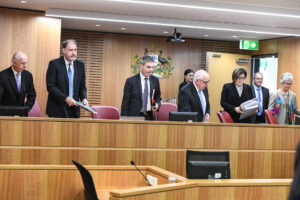As profits rise, workers continue to be the ones reducing inflation
While record company profits are dismissed as “short-term” workers continue to suffer ongoing falls in real wages
Over the past 3 years as Australia has gone through the pandemic and then the inflationary period of the past 18 months company profits have risen across most sectors while workers have seen their wages fall further behind inflation. The latest data from the Fair Work Commission (FWC) shows that any suggestions of a wage breakout are a cruel joke and the most recent enterprise agreements delivering annualize wage growth of less than half the current rate of inflation.
When the most recent quarterly enterprise agreements figures showed private sector agreements average a 3.5% annual wage growth – up from 2.9% in the September quarter last year – conservative commentators and business economists suggested this was a sign that wage growth was about to get out of control. One economist was reported as saying the growth “should be of some concern to the RBA”.
And yet while the quarterly data is more all-encompassing the fortnightly release of figures from the FWC showing the average wage rise of agreements lodged in the past 14 days repealed that there was no sign of a wages breakout.
Indeed the most recent data shows that in the fortnight to 21 April, the average wage rise of the 142 agreements covering 24,397 employees was just 3.1% for an average of 2.3 years.
But while workers are going backwards this week we have seen reports of retail companies increasing their profit margins. While company CEO, such as NAB’s Ross McEwan explain away record bank profits as merely “limited, very short-term”, workers are the ones locked into ongoing real wages decline.
The weighted average of agreements over the past 3 months shows no sign of employees getting excessive wage rises. Indeed it shows that they continue to be the ones suffering the most in the battle to reduce inflation. Wage rises below inflation are inherently deflationary, and the current level of wage growth being delivered is barely enough to achieve real wage growth in times when inflation is rising within the RBA’s target band of 2% to 3%.
There is no wage-price spiral. There is a profit-price spiral. And each release of new data only just confirms that workers have suffered by being forced to accept real wage losses, while companies make record profits.
Between the Lines Newsletter
The biggest stories and the best analysis from the team at the Australia Institute, delivered to your inbox every fortnight.
You might also like
When targeting inflation, the RBA misses more often than it hits
With the fight against high inflation now over, will the Reserve Bank fail to learn the lessons of the past and allow inflation to fall below 2%?
Corporate Profits Must Take Hit to Save Workers
Historically high corporate profits must take a hit if workers are to claw back real wage losses from the inflationary crisis, according to new research from the Australia Institute’s Centre for Future Work.
The continuing irrelevance of minimum wages to future inflation
Minimum and award wages should grow by 5 to 9 per cent this year

